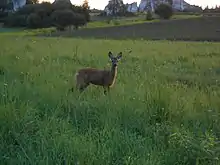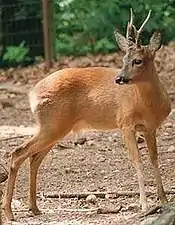Capreolus
| Capreolus | |
|---|---|
 | |
| A male and a female European roe deer | |
| Scientific classification | |
| Kingdom: | Animalia |
| Phylum: | Chordata |
| Class: | Mammalia |
| Order: | Artiodactyla |
| Family: | Cervidae |
| Subfamily: | Capreolinae |
| Genus: | Capreolus Gray, 1821 |
| Type species | |
| Capreolus capreolus | |
| Species | |

Capreolus is a genus of deer, the roe deer.
Etymology
English roe is from Old English ra or rá, from raha, from Proto-Germanic *raikhaz, cognate to Old Norse ra, Old Saxon reho, Middle Dutch and Dutch ree, Old High German reh, German Reh. It is perhaps ultimately derived from a PIE root *rei-, meaning "streaked, spotted or striped".[1][2]
The word is attested on the 5th-century Caistor-by-Norwich astragalus -a roe deer talus bone, written in Elder Futhark as ᚱᚨᛇᚺᚨᚾ, transliterated as raïhan.[3][4]
In the English language this animal was originally simply called a 'roe', but over time the word 'roe' has become a qualifier and the creature is now usually call a 'roe deer'.[5]
The Koiné Greek name πύγαργος, transliterated 'pygargos', mentioned in the Septuagint and the works of various writers such as Hesychius, Herodotus and later Pliny,[6] was originally thought to refer to this species (in many European traslations of the Bible), although it is now more often believed to refer to the Addax. It is derived from the words pyge 'buttocks' and argo 'white'.
The taxonomic name Capreolus is derived from capra or caprea, meaning 'billy goat', with the diminutive suffix -olus. The meaning of word in Latin is not entirely clear: it may have meant 'ibex' or 'chamois'.[7] The roe was also known as capraginus or capruginus in Latin.[8]
Systematics
Roe deer are most closely related to the water deer, and, counterintutively, the three species in this group, called the Capreolini, are most closely related to moose and reindeer.[9]
Although roe deer were once classified as belonging to the Cervinae subfamily, they are now classified as part of the Odocoileinae, which includes the deer from the New World.[10]
Palaeontology
Roe deer are thought to have evolved from a species in the Eurasian genus Procapreolus,[9][11] with some 10 species occurring from the Late Miocene to the Early Pleistocene, which moved from the east to Central Europe over the millennia, where Procapreolus cusanus occurred,[11] also classified as Capreolus cusanus. It may not have evolved from C. cusanus, however, because the two extant species split from each other 1.375 and 2.75 Myr ago,[12] and the western species first appeared in Europe 600 thousand years ago.[13]
The Siberian roe deer had split into two subspecies, C. pygargus pygargus and C. pygargus tianschanicus in the interval between 229 and 462.3 thousand years ago.[12]
The distribution of the European species has fluctuated often since entering Europe. During the some periods during the last Ice Age it was present in central Europe, but during the Last Glacial Maximum it retreated to refugia in the Iberian Peninsula (two refugia here), southern France, Italy (likely two), the Balkans and the Carpathians. When last ice age ended the species initially abruptly expanded north of the Alps to Germany during the Greenland Interstadial, 12.5–10.8 thousand years ago, but during the cooling of the Younger Dryas, 10.8–10 thousand years ago, it appears to have disappeared again from this region. It reappeared 9.7–9.5 thousand years ago, reaching northern central Europe. The modern population in this area appears to have recolonised it from the Carpathians and/or further east, but not the Balkans or other refugia. This is opposite to the red deer, which recolonised Europe from Iberia. There has been much admixture of these populations where they meet, also possibly due to human intervention in some cases.[13] It had become a very common species by the Late Neolithic, as farming by humans spread across the continent, which modified the environment so that more open habitat was created from the woodland, which advantaged the creatures.[14]
Species
There are at least two extant species:
| Image | Scientific name | Common Name | Distribution |
|---|---|---|---|
11.jpg.webp) | Capreolus capreolus | European roe deer | Scotland south to the Mediterranean and east to Iran and the Caucasus. |
 | Capreolus pygargus | Siberian roe deer | Urals south to the Caucasus and east to Manchuria. |
Both species have seen their populations increase, both around the 1930s. In recent times, since the 1960s,[10] the two species have become sympatric where their distributions meet, and there is now a broad 'hybridization zone' running from right side of the Volga River up to eastern Poland. It is extremely difficult for hunters to know which species they have bagged.[15] In line with Haldane's rule, female hybrids of the two taxa are fertile while male hybrids are not.[13][16] Hybrids are much larger than normal and a cesarean section was sometimes needed to birth the fawns, becoming larger than their mothers at the age of 4-5 months. F1 hybrid males may be sterile, but backcrosses with the females is possible.[16]
22% of the animals around Moscow carry the mtDNA of the European roe deer and 78% of the Siberian. In the Volgograd region the European deer predominates.[15] In Stavropol and Dnepropetrovsk regions of Ukraine most of the roe are Siberian.[15][17] In northeastern Poland there is also evidence of introgression with the Siberian deer, which was likely introduced.[18] In some cases, such as around Moscow, former introductions of European stock is likely responsible.[15] It is thought that during the Middle Ages the two species were kept apart due to hunting pressure and an abundance of predators, the different populations may have met in the period before that, but during the Ice Age they were also kept apart.[10]
References
- Harper, Douglas (2020). "Roe". Online Etymological Dictionary. Douglas Harper. Retrieved 20 November 2020.
- Johnson, Mary Lynch (1927). A Modern English - Old English Dictionary (PhD Dissertation). Meredith College. Retrieved 20 November 2020.
- "Caistor-by-Norwich, astragalus" (in German). RUNES: Forshungsproject der Akadmeia der Wissenschaften zu Gottingen. Retrieved 18 October 2019.
- Waxenberger, Gaby (2006). "The Yew-Rune and the Runes Haglaz, Gyfu, Ior, and Is in the Old English Corpus". In Stoklund, Marie; Nielsen, Michael Lerche; et al. (eds.). Runes and their secrets: Studies in Runology. Museum Tusculanum Press. pp. 385–414. ISBN 87-635-0428-6. pp. 389-91.
- Lister, Adrian M.; Grubb, P.; Summer, S. R. M. (1998). "Taxonomy, morphology and evolution of European roe deer". In Andersen, Reidar; Duncan, P.; Linnell, John D. C. (eds.). The European roe deer: the biology of success. Oslo: Scandinavian University Press. p. 23–46.
- Hofmann, Johann Jacob (1698). "Pygargus". Lexicon Universale. Leiden: Jacob Hackium et al.
- Lewis, Charlton Thomas; Short, Charles (1879). A Latin Dictionary. Oxford: Clarendon Press.
- Gaffiot, Félix (1934). "Capraginus". Dictionnaire Illustré Latin-Français (in French). Paris: Hachette. p. 261.
- Heckeberg, Nicola S. (18 February 2020). "The systematics of the Cervidae: a total evidence approach". PeerJ. 8: e8114. doi:10.7717/peerj.8114. PMC 7034380. PMID 32110477.
- Hewison, A. J. M.; Danilkin, A. A. (2001). "Evidence for separate specific status of European (Capreolus capreolus) and Siberian (C. pygargus) roe deer". Mammalian Biology - Zeitschrift fur Saugetierkunde. 66: 13–21. Retrieved 21 November 2020.
- Valli, Andrea M. F. (1 February 2010). "Dispersion of the genus Procapreolus and the relationships between Procapreolus cusanus and the roe deer (Capreolus)". Quaternary International. 212 (2): 80–85. doi:10.1016/j.quaint.2008.11.002.
- Petrosian, V. G.; Tokarskaia, O. N.; Danilkin, A. A.; Ryskov, A. P. (June 2002). "[Quantitative analysis of genetic parameters in populations of European (Capreolus capreolus L.) and Siberian (Capreolus pygargus Pall.) roe deer with RAPD markers]". Genetika (in Russian). 38 (6): 812–819. PMID 12138780.
- Sommer, Robert S.; Fahlke, J. M.; Schmölcke, Ulrich; Benecke, N.; Zachos, F. E. (October 2008). "Quaternary history of the European roe deer Capreolus capreolus". Mammal Review. 39 (1): 1–16. doi:10.1111/j.1365-2907.2008.00137.x. Retrieved 20 November 2020.
- Boyle, K. V. (2006). "The Roe Deer: Conservation of a Native Species". In Serjeantson, D.; Field, D. (eds.). Neolithic wild game animals in Western Europe: The question of hunting. Oxford: Oxbow Books. pp. 10–23. ISBN 978-1-84217-214-8.
- Plakhina, Daria Aleksandrovna; Zvychainaya, E. Yu.; Kholodova, Marina Vladimirovna; Danilkin, Alexey (July 2014). "Identification of European (Capreolus capreolus L.) and Siberian (C. pygargus Pall.) roe deer hybrids by microsatellite marker analysis". Russian Journal of Genetics. 50 (7): 757–762. doi:10.1134/S1022795414070151. PMID 25720144. S2CID 7659420. Retrieved 21 November 2020.
- Stubbe, H.; Brukhgol'ts, Z. (1979). "[Experiments of hybridization of the roe and tartarian deer Capreolus capreolus capreolus x Capreolus capreolus pygargus]". Zoologicheskiĭ zhurnal (in Russian). 58 (9): 1398–1403. Retrieved 21 November 2020.
- Danilkin, Alexey; Plakhina, Daria Aleksandrovna; Zvychaynaya, E. Y.; Domnich, A. V. (November 2017). "Siberian Roe Deer (Capreolus pygargus Pallas, 1771) in Ukraine: Analysis of the Mitochondrial and Nuclear DNA". Biology Bulletin. 44 (6): 575–583. doi:10.1134/S106235901706005X. S2CID 3542209.
- Olano-Marin, Juanita; Plis, Kamila; Sönnichsen, Leif; Borowik, Tomasz; Niedziałkowska, Magdalena; Jędrzejewska, Bogumiła (1 October 2014). "Weak Population Structure in European Roe Deer (Capreolus capreolus) and Evidence of Introgressive Hybridization with Siberian Roe Deer (C. pygargus) in Northeastern Poland". PLOS ONE. 9 (10): e109147. doi:10.1371/journal.pone.0109147. PMC 4182808. PMID 25271423.